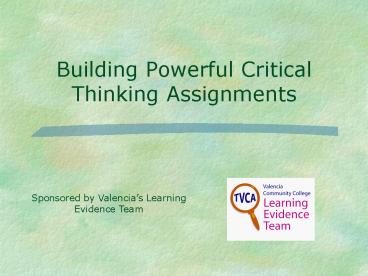Building Powerful Critical Thinking Assignments - PowerPoint PPT Presentation
1 / 34
Title:
Building Powerful Critical Thinking Assignments
Description:
Building Powerful Critical Thinking Assignments. Sponsored by Valencia's Learning ... Teaching for Critical Thinking. Assessing for THINK. 4. Your thoughts about THINK ... – PowerPoint PPT presentation
Number of Views:66
Avg rating:3.0/5.0
Title: Building Powerful Critical Thinking Assignments
1
Building Powerful Critical Thinking Assignments
Sponsored by Valencias Learning Evidence Team
2
The T? Process
- Workshop Understanding the THINK Rubric
- Workshop Building Powerful CT Assignments
- Score and submit student work
- Focus group on THINK assessment
3
Preview of Todays Session
- Thoughts about the THINK Rubric
- Teaching for Critical Thinking
- Assessing for THINK
4
Your thoughts about THINK
- Analyze
- Apply
- Multiple perspectives
- Draw conclusions
- Synthesize
- Refer to the holistic and analytic rubrics
5
Getting Started
6
Identify an assignment
- Identify a major assignment or activity in your
course or student experience. - Ask yourself How would this be a good test of
how well students THINK?
7
Clarify the learning outcome
- Clarify what student learning you hope to observe
and assess in this assignment or task. - Refer to your course outcomes, if applicable.
8
Enhance its THINK-ability
- Revise the assignment to engage students in the
dimensions of THINK
- Analyze
- Apply
- Multiple perspectives
- Draw conclusions
- Synthesize
9
Enhancing Think-ability
10
1 Go higher order
- Create higher order tasks for students
- Ask them to apply, analyze, evaluate, and create
11
1 Go higher order
- Creating
- Evaluating
- Analysing
- Applying
- Understanding
- Remembering
12
BLOOMS REVISED TAXONOMY
- CreatingGenerating new ideas, products, or ways
of viewing thingsDesigning, constructing,
planning, producing, inventing. - EvaluatingJustifying a decision or course of
actionChecking, hypothesising, critiquing,
experimenting, judging - AnalysingBreaking information into parts to
explore understandings and relationshipsComparing
, organising, deconstructing, interrogating,
finding - ApplyingUsing information in another familiar
situationImplementing, carrying out, using,
executing - UnderstandingExplaining ideas or
conceptsInterpreting, summarising, paraphrasing,
classifying, explaining - RememberingRecalling informationRecognising,
listing, describing, retrieving, naming, finding
Higher-order thinking
13
1 Go higher order
- In your assignment or activity
- How could you ask students to do more
- Application? Analysis? Evaluation? Creative
synthesis or invention?
14
1 Go higher order
- Share and compare your responses
15
2 Create debate-ability and dialogue
- Pose questions or problems with multiple
solutions or perspectives - Engage students with each others multiple
perspectives and alternate solutions
See C. Bonwell and J. Eison, Active Learning
16
2 Create debate-ability and dialogue
- In your assignment or activity
- How could you build in debatable questions or
problems? - How could you build in student-to-student
interaction and collaboration?
17
2 Debate-ability and dialogue
- Share and compare your responses
18
3 Get real
- Highlight the assignments relevance or
resemblance to real-world tasks (authenticity) - Connect to career, marriage and family, religious
and civic life, consumer interests, etc.
19
Authentic assessment
- involves students with issues they regard as
vital concerns - help students to see big ideas and general
principles - involve students in real-life experiences
20
3 Get real
- In your assignment or activity
- How could you highlight the assignments
connection to real life? - How could you embed the assessment task in a
real-life problem or situation?
21
3 Get real
- Share and compare your responses
22
Enhancing Think-ability
- Go higher-order
- Build in debate-ability and dialogue
- Get real
23
Assessing for THINK
24
Criteria for a good THINK assignment
- Engages at least 3 of the THINK dimensions
- Is challenging enough to produce a range of
student achievement
25
THINK criteria (cont.)
- Is intelligible to and assessable by non-experts
in the discipline - Short enough to assess quickly (no more than
1,000 words)
26
Create a custom rubric
- Use at least three of the THINK dimensions
- Add custom rowsi.e., other traits or
features of student performance - Tie rubric to the assessment task (see worksheet)
27
Create a rubric
- Using the rubric worksheet, jot ideas for the
THINK rubric to use with your assignment or
assessment task
28
Create a rubric
- Share and compare your progress so far
29
Get feedback
- Between today and the date you administer your
assignment - Share your draft assignment and THINK rubric with
colleagues and fellow THINKsters
30
Administer the assignment
- Direct students to identify their work with VID
- If possible, ask students to submit two copies of
their work - Make no grading marks or comments on the student
work to be submitted to LET
31
Score the assignment for THINK
- Grade the assignment as you normally would for
your course. - Score the clean set for students demonstrated
mastery of THINK (see Think Quick Score) - Attach your THINK Score Sheet to the assignment
32
Score the assignment (cont.)
- Score enough student assignments to accumulate 3
or 4 examples of different achievement levels - Low-medium-high ORBeginning Developing
Competent - Accomplished
33
Score the assignment (cont.)
- Submit your scored samples to the Learning
Evidence Team - Complete a self-assessment reflection about your
application of the THINK rubric
34
THINK Focus Group
- Join members of the LET and Valencia colleagues
in collegial dialogue about assessment of THINK
(April/May 2006)

